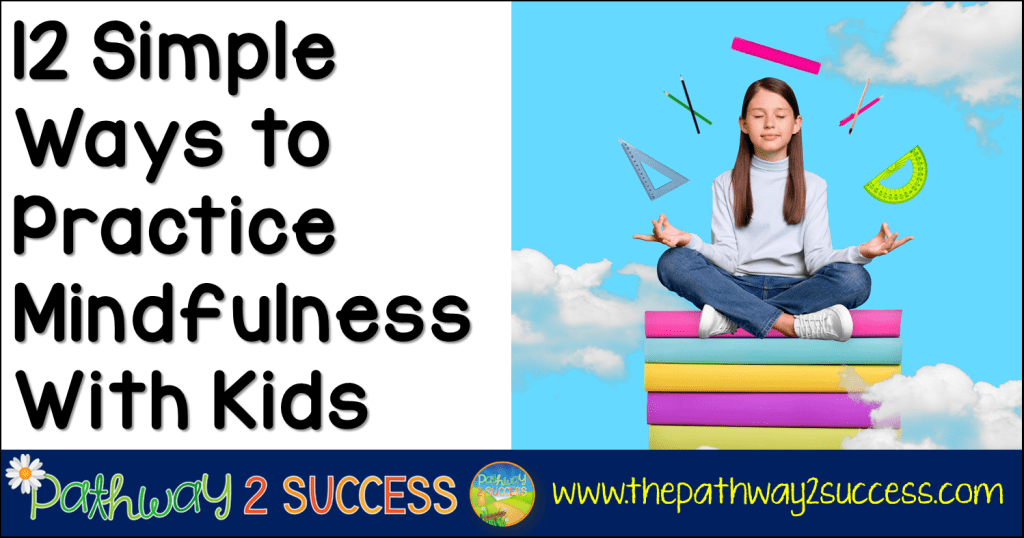
Mindfulness is a self-regulation strategy. With practice, it can help us feel calm, confident, and focused. And while it’s very helpful for us, as adults, mindfulness is a powerful skill we can teach to children and young adults.
The goal of this article is to promote simple mindful strategies you can try with your students (or kids at home). Mindfulness is about focusing on the present. That means we don’t need much at all to practice mindfulness, just our bodies, minds, and the “right now.”
Here are 12 simple ways to practice mindfulness with children and teens:

Practice breathing techniques.
Breathing techniques are one of the first strategies to practice and teach mindfulness. In many ways, breathing is the basis to everything else; when we can calm our breathing, we can calm our bodies and minds.
- Balloon Breathing – Imagine your belly is a balloon. Slowly breathe in and feel your belly expand. Then, slowly breathe out.
- 4-7-8 Breathing – Slowly breathe in to the count of four seconds. Hold your breath for seven seconds. Then, slowly exhale for eight.

Mindfully listen to music.
The idea of mindful listening is that you are not just listening to music, but focusing on the individual instruments and sounds of what you hear. This process alone puts you in the moment. Consider trying different genres of music. Nature sounds work well too!
Take a mindful walk.
Get outside! Take 10-15 minutes to just walk outside and observe nature. Consider what you see, hear, smell, feel, and even taste. You can give kids a clipboard to document their findings as they explore.

Spend time journal writing.
Use journal writing as a mindful strategy. Provide a simple prompt, set calming music, and allow time to just write. Some mindful journal prompts to try include:
- Take time to reflect. What is one way you have grown this year?
- Imagine you are a Bald Eagle soaring through the skies. What might you see, hear, feel, smell, and taste?
- What are five wishes you have for the world today?
- What are you grateful for today?

Recite positive affirmations.
There is so much power in positive affirmations. These inspiring self-talk statements remind us that we’re capable, strong, and focused on success. Have kids choose their favorite self-talk statements, make a list, and recite those together. This can even be a daily morning ritual to start the day.

Practice yoga or stretching.
Yoga and gentle stretching integrate movement with mindfulness. Some of my favorite simple postures include tree pose, warrior pose, and cobra pose.
Check in with your emotions.
Pause and connect with your inner feelings. This mindfulness strategy can help kids and teens focus on the “right now” while also building self-awareness and self-regulation skills. Use these free emotions check-in sheets to make an emotions check-in part of your every day routine.

Read guided imagery for relaxation.
Guided imagery invites your mind to travel somewhere else for a period of time. You might imagine you are at the beach listening to the crashing of the waves, floating on a cloud, or traveling through a rain forest filled with wildlife. There are a number of guided imagery activities you can test out on Youtube for yourself! Here is one by John Hopkins Hospital just for children.
Take a mindful brain break.
Brain breaks give a quick pause in the day. These can be used during a transition from one subject to another, after lunch or recess, or prior to an assessment. Some of my favorite mindful brain breaks incorporate nature and movement.
- Slow and Steady – Stand up and imagine you are a turtle. Walk and move slowly as you breathe in and out. Say a positive thought to yourself for each step you take.
- Colors of the Rainbow – Stop and look around. Notice what you see. Find something each color of the rainbow.

Spend extra time outside.
Even in times when you can’t walk or explore too far, try spending time outside. Sit and listen to the sounds of nature as you breathe in and out slowly. Learn more about mindful activities to try outside.
Draw, color, or doodle.
Play calming music and draw, color, or just doodle. Mindful coloring pages work excellent for this activity. What’s most important is to teach kids how to mindfully color. This means just coloring in the moment, and not worrying about what looks “right” or “wrong.” Just breathe, color, and be.

Use senses to observe an object.
Choose any object around you; this can be anything from a shoe to a water bottle. Use your senses to observe the object. What does it look like? What shapes do you notice? What materials is it made of? What do you notice that you’ve never really noticed before? These seemingly simple questions encourage our mind to be focused on the present.







Leave a Reply